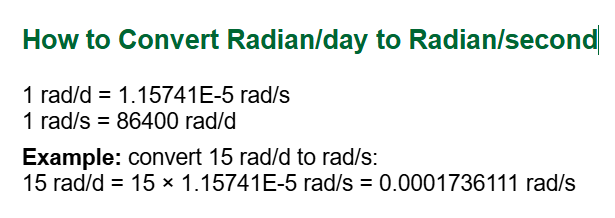 Home
Home
 Back
Back

Definition: This converter transforms angular velocity values between rad/d and rad/s. Angular velocity measures the rate of change of angular displacement.
Purpose: Useful in physics and engineering for converting angular velocity units in applications involving slow rotational motion, such as astronomical observations.
The converter uses conversion factors relative to the base unit rad/s:
Steps:
This conversion is critical for:
Example 1: Convert 1 rad/d to rad/s:
Result: 1.1574e-5 rad/s
Example 2: Convert 1 rad/s to rad/d:
Result: 86399.98150 rad/d
Q: What is angular velocity?
A: Angular velocity is the rate of change of angular displacement, typically measured in rad/s.
Q: Why convert between rad/d and rad/s?
A: Different applications use different time scales; rad/d is useful for slow rotations (e.g., Earth’s rotation), while rad/s is standard for faster motions.
Q: How many seconds are in a day?
A: There are 86,400 seconds in a day (24 hours × 60 minutes × 60 seconds), which is why 1 rad/d = 1/86,400 rad/s ≈ 1.15741E-5 rad/s.
Q: Can this converter be used for all angular velocity scenarios?
A: This converter is specific to rad/d and rad/s, but the principle applies to any angular velocity conversion.